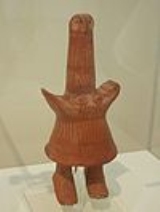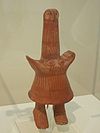
Daidala
Encyclopedia
Daidala is a Greek
festival of reconciliation that was held every four (or seven) years in honor of Hera
at Plataea
in Boeotia
. Every fourteen cycles a Great Daidala was celebrated all over Boeotia. In the great festival, a wooden statue, referred to as a daidala, was led in procession in a wagon and then burned in a fire. This archaic custom was explained with a myth
(an aition or "origin myth") about Hera and Zeus
, which is related by Pausanias
:
 In a variant of the origin myth Zeus was advised by a hero named Alalkomeneus.
In a variant of the origin myth Zeus was advised by a hero named Alalkomeneus.
The cult of Hera in Plataea was one of the major cults of the city. The Daidala at Plataea was celebrated every four years. At the Daidala the Plataeans went to a sacred oak grove and by divination
chose an oak to be carved into a statue, to which they gave the name Daidala, with the connotation that it was crafted or fashioned (compare "Daedalus
").
After fourteen four-year cycles, the Great Daidala festival was celebrated, which drew together a number of cities in a reconciliation celebration of great importance. At the start of the Great Daidala one wooden figure was chosen from the many that had accumulated and designated the bride. The wooden idol was prepared as a bride for a wedding, first with a ritual bath in the River Asopus
. Next the wooden bride was dressed, set in a wagon with an attendant. The wagon led a procession up to Mount Kithairon
with the participants singing an epithalamion.
At the mountaintop there was an altar
and a pyre
, where for each community a cow was sacrificed for Hera and a bull for Zeus. The wooden bride was also placed on the altar, and all was immolated in a magnificent hecatomb
.
Greek mythology
Greek mythology is the body of myths and legends belonging to the ancient Greeks, concerning their gods and heroes, the nature of the world, and the origins and significance of their own cult and ritual practices. They were a part of religion in ancient Greece...
festival of reconciliation that was held every four (or seven) years in honor of Hera
Hera
Hera was the wife and one of three sisters of Zeus in the Olympian pantheon of Greek mythology and religion. Her chief function was as the goddess of women and marriage. Her counterpart in the religion of ancient Rome was Juno. The cow and the peacock were sacred to her...
at Plataea
Plataea
Plataea or Plataeae was an ancient city, located in Greece in southeastern Boeotia, south of Thebes. It was the location of the Battle of Plataea in 479 BC, in which an alliance of Greek city-states defeated the Persians....
in Boeotia
Boeotia
Boeotia, also spelled Beotia and Bœotia , is one of the regional units of Greece. It is part of the region of Central Greece. It was also a region of ancient Greece. Its capital is Livadeia, the second largest city being Thebes.-Geography:...
. Every fourteen cycles a Great Daidala was celebrated all over Boeotia. In the great festival, a wooden statue, referred to as a daidala, was led in procession in a wagon and then burned in a fire. This archaic custom was explained with a myth
Mythology
The term mythology can refer either to the study of myths, or to a body or collection of myths. As examples, comparative mythology is the study of connections between myths from different cultures, whereas Greek mythology is the body of myths from ancient Greece...
(an aition or "origin myth") about Hera and Zeus
Zeus
In the ancient Greek religion, Zeus was the "Father of Gods and men" who ruled the Olympians of Mount Olympus as a father ruled the family. He was the god of sky and thunder in Greek mythology. His Roman counterpart is Jupiter and his Etruscan counterpart is Tinia.Zeus was the child of Cronus...
, which is related by Pausanias
Pausanias (geographer)
Pausanias was a Greek traveler and geographer of the 2nd century AD, who lived in the times of Hadrian, Antoninus Pius and Marcus Aurelius. He is famous for his Description of Greece , a lengthy work that describes ancient Greece from firsthand observations, and is a crucial link between classical...
:
- "Hera, they say, was for some reason or other angry with Zeus, and had retreated to Euboia. Zeus, failing to make her change her mind, visited Kithaeron, at that time despot in PlataeaPlataeaPlataea or Plataeae was an ancient city, located in Greece in southeastern Boeotia, south of Thebes. It was the location of the Battle of Plataea in 479 BC, in which an alliance of Greek city-states defeated the Persians....
, who surpassed all men for his cleverness. So he ordered Zeus to make an image of wood, and to carry it, wrapped up, in a bullock wagon, and to say that he was celebrating his marriage with Plataia, the daughter of Asopos. So Zeus followed the advice of KithaironKithaironKithairon is a mountain range about 10 mi long, in central Greece, standing between Boeotia in the north and Attica in the south. It is mainly composed of limestone and rises to 4,623 ft...
. Hera heard the news at once, and at once appeared on the scene. But when she came near the wagon and tore away the dress from the image, she was pleased at the deceit, on finding it a wooden image and not a bride, and was reconciled to Zeus. To commemorate this reconciliation they celebrate a festival called Daidala, because the men of old time gave the name of daidala to wooden images... the Plataeans [of Plataia, Boiotia] hold the festival of the Daidala every six years, according to the local guide, but really at a shorter interval. I wanted very much to calculate exactly the interval between one Daedala and the next, but I was unable to do so. In this way they celebrate the feast."-
- - Pausanias (9.3.1-3)
-

The cult of Hera in Plataea was one of the major cults of the city. The Daidala at Plataea was celebrated every four years. At the Daidala the Plataeans went to a sacred oak grove and by divination
Divination
Divination is the attempt to gain insight into a question or situation by way of an occultic standardized process or ritual...
chose an oak to be carved into a statue, to which they gave the name Daidala, with the connotation that it was crafted or fashioned (compare "Daedalus
Daedalus
In Greek mythology, Daedalus was a skillful craftsman and artisan.-Family:...
").
After fourteen four-year cycles, the Great Daidala festival was celebrated, which drew together a number of cities in a reconciliation celebration of great importance. At the start of the Great Daidala one wooden figure was chosen from the many that had accumulated and designated the bride. The wooden idol was prepared as a bride for a wedding, first with a ritual bath in the River Asopus
Asopus
Asopus or Asôpos is the name of four different rivers in Greece and one in Turkey. In Greek mythology, it was the name of the gods of those rivers.-The rivers in Greece:...
. Next the wooden bride was dressed, set in a wagon with an attendant. The wagon led a procession up to Mount Kithairon
Kithairon
Kithairon is a mountain range about 10 mi long, in central Greece, standing between Boeotia in the north and Attica in the south. It is mainly composed of limestone and rises to 4,623 ft...
with the participants singing an epithalamion.
At the mountaintop there was an altar
Altar
An altar is any structure upon which offerings such as sacrifices are made for religious purposes. Altars are usually found at shrines, and they can be located in temples, churches and other places of worship...
and a pyre
Pyre
A pyre , also known as a funeral pyre, is a structure, usually made of wood, for burning a body as part of a funeral rite...
, where for each community a cow was sacrificed for Hera and a bull for Zeus. The wooden bride was also placed on the altar, and all was immolated in a magnificent hecatomb
Hecatomb
In Ancient Greece, a Hecatomb was a sacrifice to the gods of 100 cattle . Hecatombs were offered to Greek gods Apollo, Athena, and Hera, during special religious ceremonies....
.
External links
- Cult of Hera
- Timeless Myths: the Daidala
- Jill Rossi, "Hera"

